






|
2018 |
 |
 |
 |
 |
 |
 |
 |
|
A follow-up to the previous post:
| Piotrkowska Street in B&W — a monochrome version of the original. When reviewing the original gallery page, I realized that this is a perfect subject for B&W. And, boy, was I right! This is just a monochrome conversion of the "final" color image, followed by a tad of fill light, then some extra Local Tone Mapping, and, if needed, a slight mid-tone adjustment. LTM does here a great job in opening up the shadows, but it may have a side-effect: a halo in sky areas next to bright buildings. A way to avoid it is to mask the sky off, which I did in most cases. I'm quite happy with the results. The color version is OK, but the monochrome one — better, no doubt, at least for images selected. Happy New Year again! 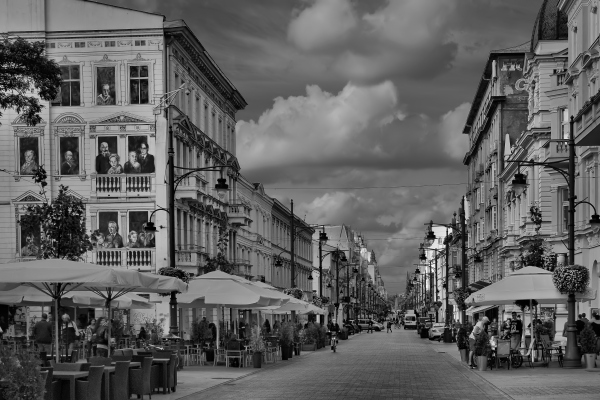
Olympus E-M1 Mk.II, MZD 12-100/4.0 @ 29 mm
|
Best Happy New Year to all friends and visitors to these pages! Thank you for sticking with me for another year, and see you around in 2019.
| As a part of wrotniak.net periodic maintenance, I went through my font-setting system, assuring compatibility with all major browsers, at least under Windows. If you haven't tried this feature yet, do it now and choose, for example, the Signika or Bahnschrift font (the first one is loaded silently from Google, the second comes with some versions of Windows 10). We have a new Gallery page: Piotrkowska Street in Łódź, Poland. If you haven't been here, you haven't been to Łódź. (See also Dec.17.) 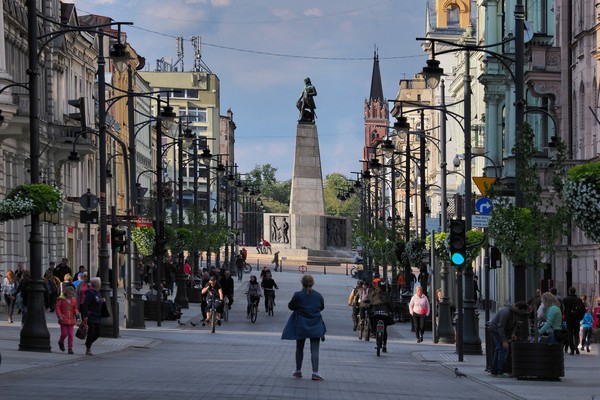
Olympus E-M1 Mk.II, MZD 12-100/4.0 @ 100 mm
| The outfit I was using for these sessions was far from the street-shooter's one. The E-M1 Mk.II is the largest and heaviest μFT body by Olympus, but at that time it was the only one not left behind in the States. Tough luck; I'm sill waiting for the Pen F Mk. II. The lens I found most useful, ironically, was the MZD 12-100/4.0 PRO. While most of my shooting was done at 12-30 mm setting, occasionally I needed to zoom in on a scene too far to be approached on foot in time. The convenience does not come free: the lens is really large, heavy, and intimidating. The MZD 12-40/2.8 PRO, while still substantial, is more manageable, and the 40 mm long end should suffice for 98% of streey use. Your pick. I also tried the Leica DG 8-18/2.8-4.0. While the extra wide angle it offers is very nice, it is not worth the price of giving up the 18-30 mm range, more useful in these circumstances (or swapping lenses on the go). On the other hand, a 14 mm wide end, while usable, is not quite wide enough for some of architectural scenes. One day I hope to try out the Lumix 12-32/3.6-5.6 if just to see if it is streetworthy. | |||||
|
Merry Christmas, everyone! (Or happy Hannukah, or just enjoy the season, pick one option.)
| A reminder: this is a good time to start cooking the famous Polish winter dish: Bigos (a.k.a. hunter's stew), using my own recipe. If you start the next day after the holidays, it should be ready just before the New Year. This picture: a can of Russian beer (the first one I've had since my last trip there in 1983), a Special Edition of Zhiguli Varnoe lager. The can art is quite remarkable: half-way between the Soviet-era socrealism and American pulp magazines of the Fifties. The mailbox I'm using for photography-related correspondence has been revived, and I will be checking it twice a week, I hope. The address is
| 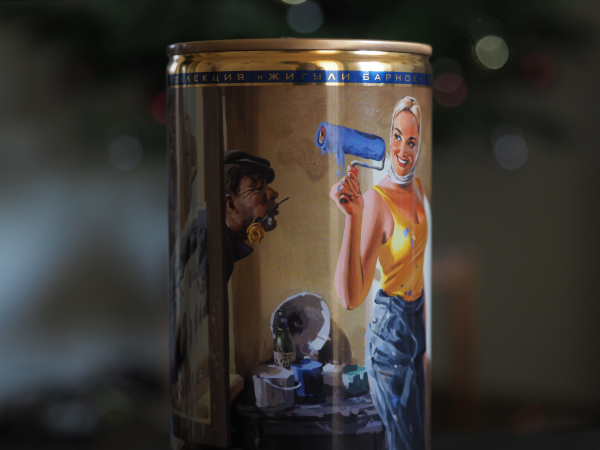
Olympus E-M1 Mk.II, MZD 12-40/2.8 @ 38 mm | |
Łódź is the place where I was born and raised: an ugly duckling of a city, sometimes referred to as "Polish Manchester"; a huge textile center which exploded from naught to almost a million over less than a century. The common opinion about it was: boring, ugly, and depressed. Not quite true: there always was, and is, some fin-de-siècle (steampunk?) beauty under the layer of neglect, but a label, once given, sticks.
|
Imagine my surprise then, when the Lonely Planet publishers declared it as #2 on their Best in Travel 2019 Best Value list, behind the Southern Nile Valley and ahead of Great Smoky Mountains and the Maldives!
So if I'll have to live the next few months, years, whatever, as an repat/expat this side of the pond, it will be in a recognized tourist destination. Makes me feel better already. This picture: Christmas lights in Piotrkowska Street, Łódź, Poland, in wintery drizzle.
Olympus E-M1 Mk.II, MZD 12-40/2.8 @ 21 mm
| 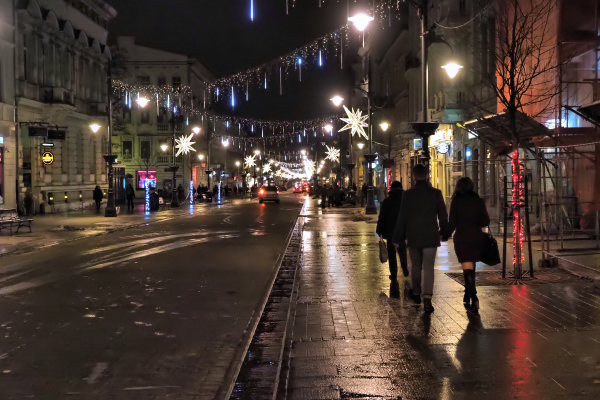
|
Good news: I'm no longer stuck here with just an E-M1.II body and two lenses. A friend, who is visiting Poland for Christmas, brought over some of the gear I left behind in Maryland: an E-M1 as a backup, E-PM1 for emergencies, MZD 12-40/2.8, MZD 75/1.8, Leica DG 8-18/2.8-4.0, my newly-acquired MZD 60/2.8 Macro (watch this space for more on that!), plus three lesser lenses, a flash unit, batteries and chargers. His wife, traveling light, brought with her just my wife's Stylus 1, a competent and civilized compact. And this is just the photo equipment...
It's good to have friends like that. Thank you, Ania and Piotr! When updating the E-M10 Mk.III, I discovered that the E-M10 Mk.II write-up was not seen (or linked to) from outside, effectively hidden. This has been fixed. At the same time, I updated the page on the original E-M10. Oops! This time I was too smart for my own good. The November 10 entry below stayed hidden for almost a month, and only now I'm making it visible. Sorry! For those who may be interested and/or who code their own HTML, here is how that happened. When working on a new part of an already posted page, I often mark that part with a style with the display attribute which is set to none on my server somewhere in California, but is overridden to something visible on my laptop (which has an extra style sheet). Therefore I can see the tagged contents only when viewing my local copy, not the server one. This allows me to update other parts of the file and to upload the modified version even while the tagged part is still not presentable. It still can be viewed on my laptop. When the tagged part is done, I only have to remove the style tag before uploading. That's what I forgot to do last time.
| My Mesa Verde Gallery page got a solid update: the original scans were postprocessed again, this time with a bit more punch. Also, a few images have been added. Sandstone is a tough subject for color photography, especially when partly lit with light scattered off some greenery. Some areas will show a green cast, others — magenta. This is most visible in recessed areas, shaded from the sky light by a rock overhang; especially when the scene is almost monochromatic (like. say, various shades of sandstone). That's exactly what we are facing here. This also may be the reason why these images may look better in monochrome.
| 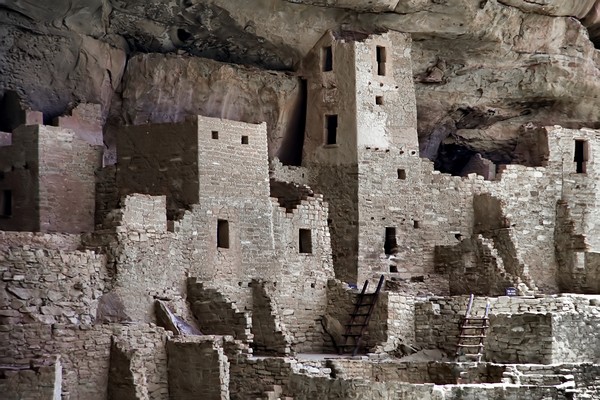
The Cliff Palace at Mesa Verde, Colorado
Recently I was able to get more familiar with the E-M10 Mk.III, so its write-up got updated. Among others, I'm showing how Olympus could have streamlined some of the camera's advanced options without crippling them. Another update: Pen E-Series article, mostly the part on E-PL9 losing the accessory port. I'm worried about the future of the Pen E line. As many of the visitors here already know, as a photographer I'm not an artist, lacking what that takes, but happy to remain at the amateur enthusiast level. From time to time, however, I visit art-related Web sites, auctions or art galleries and similar places, if just to see what's going on there at the top. Also, to get some idea about how the line between art and mundane is drawn.
I don't do that very often, but every time I do, I learn something new. The last time I discovered
| And look what I found there: a print by Thomas Joshua Cooper, for a mere £3,750 ($4,900, plus shipping, tax, and service). It is offered for sale here by Ingleby Gallery in Edinburgh, Scotland. In case the link gets broken, the thumbnail points to a screen shot of the original page. (This is a low-resolution representation of a work of art; it is being used here, to the best of my understanding, within the fair use restrictions.) The 37.5×45 cm print is a part of a Limited Edition of four, and is priced well below what I expected.
Another print by this artist is offered at £10,000; for others, like
| 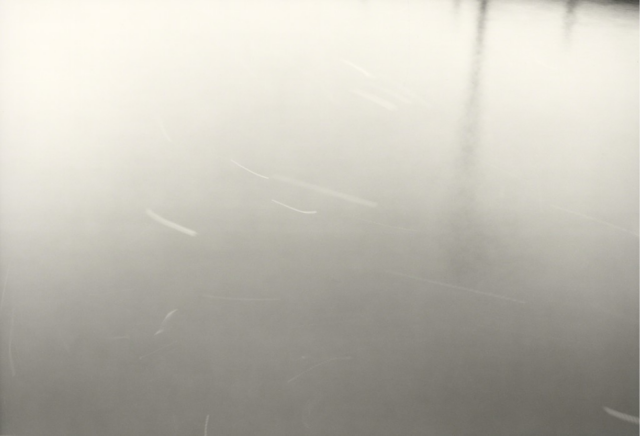
The mouth of the water of Leith, Rennie's Lock, Edinburgh, Scotland ©1997-2018 by Thomas Joshua Cooper Silver gelatin print by the artist, selenium hand-toned From the description: "Using an 1898 Agfa field camera and specially made photographic plates, [...] Composing only outdoors, he captures each site in a single exposure, stressing the 'made' and 'built' quality of each print over its documentary or snapshot elements." Well put: no documentary or snapshot elements here. Indeed, nothing stands between the viewer and the "made" and/or "built" quality of the image. I'm getting closer to understanding the art of photography. No, I'm not inventing this. | ||||||
Another Gallery page: More of Utah & Arizona, includes, among others, the picture shown below. At the same time, I submitted my Monument Valley scans to another round of postprocessing — a bit bolder this time; have a look.
|
This picture: Park Avenue in the Arches National Park, Utah.
Remember the Biotar 75/1.5 and 58/2.0 revival? Crowdfunded on Kickstarter and Indiegogo, with first lenses promised to ship the past Summer. Kaboom! In August, Net SE, the actual parent company behind these Biotars, declared insolvency, which means: "Thank you for the money. Sorry, no lenses or refunds. Nice meeting you."
| 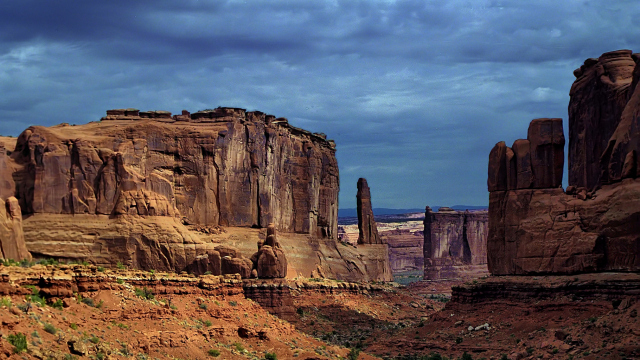
Minolta 600si, no data on lens and exposure Over the last few years, Net SE secured the rights to some big trademarks of defunct optical firms: Oprema, Meyer Optic, Goerz, Schacht, Ihagee (!), possibly others. The Meyer Optic brand was chosen as a brand name for, among others, the "revived" Trioplan lenses few years ago (I understand some were actually delivered), while Oprema was used to resurrect the Biotars (with the actual manufacturing farmed out to Tokina). Personally, I find this practice of recycling dead brand names misleading, not to say repulsive. There is no continuity, no connection between the two entities sharing just a label. All these shell companies folded, too. So, no Biotars, no more Trioplans. no money back. See the petapixel.com article on Net SE demise and a follow-up for more on this subject. Well, I still have my original 75/1.5 Biotar, and for actual shooting I prefer the MZD 75/1.8 anyway. | |||
|
|
More Maryland pumpkins at my neighbors' farm: Rte. 424, SE of Crofton, just before U.S. 50.
Update: See also my new Pumpkin Patch Gallery page with more pictures, spanning over a decade. Compare three crops: the native 4:3, wide 16:9, and square 1:1. The 16:9 (strongly cropped), is my preference — that's why we may need more than 10 or 12 megapixels. I've been experimenting with the Perfectly Clear plugin of the fix-it-all type. Generally, I don't like that kind, but this one gives me consistently good results applied to in-camera JPEGs. Worth a test drive.
| 
Olympus E-M1, MZD 12-40/2.8 ED at 34 mm
| My E-M1 Mark III Wish List is, for now at least, complete; I'm still annotating it, though, so the text is evolving. I'm beginning to realize now, that most of the quality-of-life and stop-this-madness improvements listed there do not require new Mk.III hardware and could be implemented as firmware patches. Don't hold your breath: Olympus has a poor record of using firmware updates to fix design problems. (Well, they are not stellar in doing that in updated hardware, either: the Bracketing Mess was introduced in 2005 and is still around.) One possibility I'm raising in the wish list (perhaps the toughest one) is correcting the lens diffraction by image deconvolution in firmware. This can be done the easy way (the "blind" deconvolution) or the right way (using the lens data), and the problem is highly non-trivial. Deconvolution in Image Processing is my attempt of a relatively simple introduction to the subject (Part 1, with more to come). Not an easy reading, but may be worth the effort. (A warning and disclosure: I am only semi-literate on this subject, but that's better than nothing.) | ||
|
|
|
It's pumpkin time in Maryland. Here: the Doepkens' Farm in Gambrills, Maryland. Currently run by Bill Doepkens (the fifth generation, at least) it is a local institution, not to be missed (remember to grab some fresh eggs, too).
Waiting for the E-M1 Mark III? Right, Mark II will be two years old this December, so something should happen within the twelve months that follow. How can you improve upon a classic? Try a mix of new features (progress in technology), quality-of-life improvements (making you enjoy your gear more), and, last but not least, correcting any questionable (and often most irritating) design decisions or omissions. This first draft of my E-M1 Mk. III Wish List presents a number of thoughts and suggestions; possibly a starting point for a discussion.
| 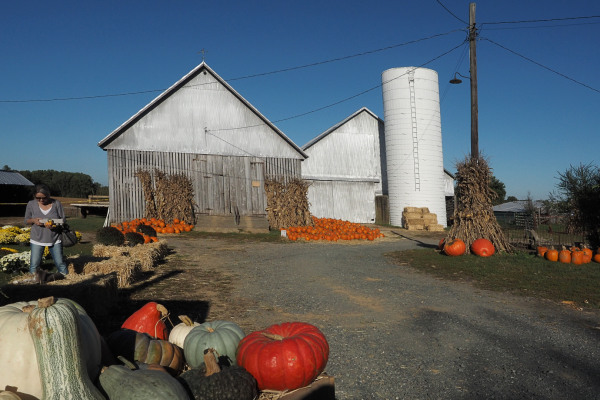
Olympus E-M1, MZD 12-40/2.8 ED at 12 mm | |
|
|
This Picture: A green heron on the Ocracoke Island, North Carolina.
The camera used was the E-510, a major step in the Olympus E-Series SLR evolution, introducing three significant features:
Actually, this was the last major step before going to Micro Four Thirds, regardless of any models introduced in-between.
| 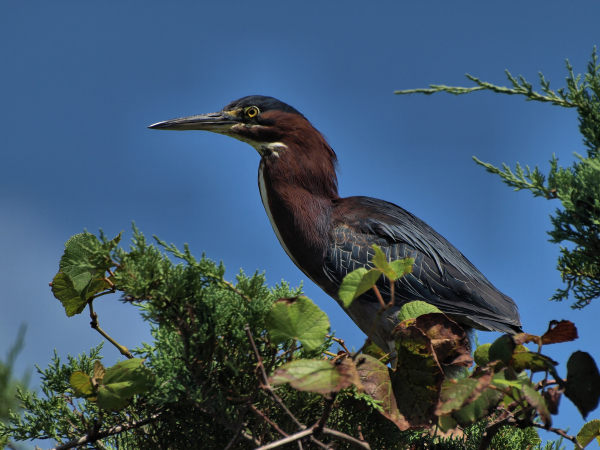
Olympus E-510, ZD 70-300/4.0-5.6 ED at 300 mm
| The E-510, after all these years, still remains an attractive, well-performing camera, usually priced at next to nothing on the used-camera market. If you are on a tight budget, looking for a system camera, try to get this one in a good working order. Remember the salvaged Grand Canyon Kodachrome scan shown here six weeks ago? It is now a part of my Grand Canyon Gallery page, including some other frames from that batch. Scan quality aside, the page may be worth a few minutes of your time. | ||
The full-frame distraction behind us, let me move to my main subject of interest: what's new in Micro Four Thirds at the Cologne show. Not much, I'm afraid. The only new equipment announced are μFT lenses:
Olympus did not show anything new. This is the explanation: "We decided to de-couple new product releases from Photokina", which implies "we've got tons of new stuff, just decided not to show it: you don't do that on a trade show". Maybe. The first (actual) quote comes from Olympus Press Event, a presentation by a high-ranking representative of Olympus Europe. Here is the whole thing on YouTube. A sad performance. Bad text, badly delivered, no conviction or enthusiasm, or even, dare I say, understanding of what's being said (or read). You don't see that often. I'm a big fan of the gifted, often brilliant, Olympus engineering team, and I think their efforts deserve a better corporate support. Some damage control, please. The Cologne Chainsaw Massacre would be, from where I stand, the best headline for what happened at the Photokina and in the preceding weeks. Let me be clear: this is not about one company taking a beating, or another gaining market share. This is about one technology replacing another, which is called "progress". What it does to individual companies is a secondary issue. The "full frame" (originally referred to as "miniature" in 1930's) market being the last bastion of SLR dominance to fall, we may say that the century of SLR is over. Go and buy one, a mechanical, film model, second-hand, to show it, still in working order, to your grandchildren 25 years from now. Anyway, a month ago we had two companies making full-frame mirrorless cameras: Leica and Sony, with the latter having 99% of the market to itself. Now they are being joined by Nikon, Canon, Panasonic, and Sigma. Something is stirring down there. Massively. Here comes Fuji. In a somewhat related development, Fujifilm, already my #1 choice in the APS-C segment, decided not to join the FF race, but to jump straight to the 44×33 mm sensor size (ironically, often referred to as "medium format"). What they brought to the show is the GFX 50R — the medium format for the rest of us: a smaller, lighter, simpler and cheaper (yet still very attractive) follow-up to their GFX 50S of 2016. Another medium-format Fuji model, the GFX 100, is currently under development (100 MP, sensor phase-detection AF and IS). Expected in 2019 at $10,000 or so. Breaking the pattern, the new, medium-format Leica S3 (44×33 mm, 63 MP) is an SLR. Available next Spring at $20,000 (body). |
Did I say "predictable" last time, commenting on the Canon EOS R announcement? Not any longer, not after what happened today at the Photokina trade show in Köln (a.k.a. Cologne), Germany.
| The L-Mount Alliance (Leica, Panasonic, and Sigma) announced a new mount specification for full-frame, mirrorless cameras (FF MILC). This mount is already used by Leica in their full-frame SL model (2017, $6000 body) and, somewhat confusingly, in two older, APS-C cameras, with the obvious caveats. Allowing other manufacturers to use the L Mount for their bodies or lenses, is, I believe, beneficial to all parties involved, unlike keeping it proprietary (which is what Canon and Nikon are doing). At 51.6 mm diameter, this mount is wider than Sony E (46.1 mm) but not as wide as Canon EF (54 mm) or Nikon's Z (55 mm). The L bayonet has four prongs (not the usual three), which should make lens misalignment more likely to result in a visible wobble (and therefore to be detected), but less likely to occur and easier to correct.
| 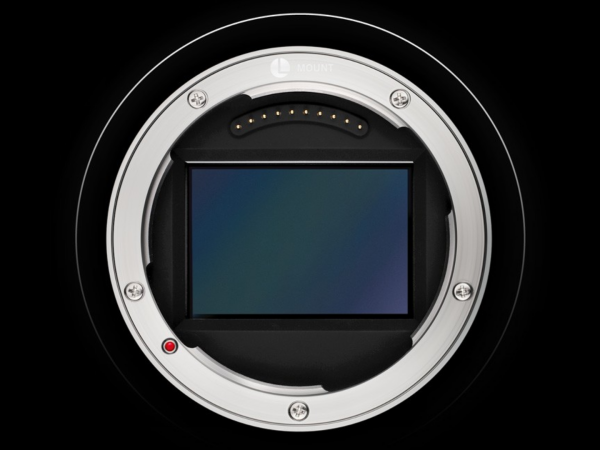
Image ©2018 by Leica Camera, GmBH
| It only gets better now. Panasonic disclosed they have two mirrorless, full-frame models in development, with expected release early next year. Not one, mind it, but two: S1 and S1R (with 'S' standing for "Professional", please don't ask me how). They brought to the show a non-working prototype, so the announced specs may still change.
| The bodies are (almost?) identical (see Nikon Z6 and Z7), differing mostly in emphasis on video versus still photography and in pixel count:
While most details of the still/video specialization can be only guessed at the moment, both will be able to record 4k video at 60 FPS. The features already known to be shared between both models include: top LCD panel, weather-proofing, two card slots (SD and XQD) and dual (lens/body) image stabilization capability. Instead of the on-sensor phase detection AF, Panasonic uses their own Depth from Defocus system. The electronic viewfinder is expected to have 4 million dots or close, OLED type.
| 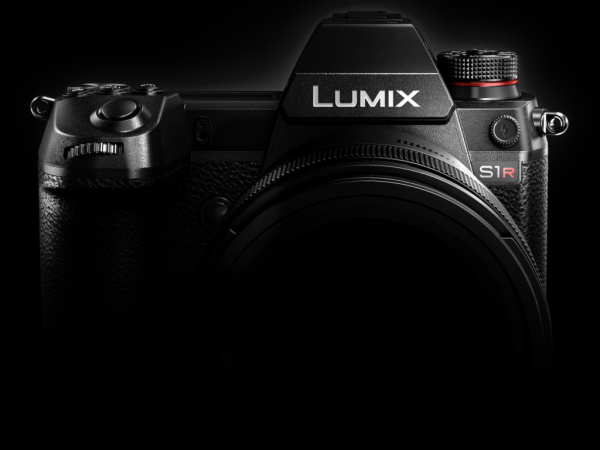
Promotional image ©2018 by Panasonic
| Interestingly, the rear monitor is of the uncommon, 2-axis tilt type (as seen in some Fujifilm models), more compact and practical than the swing-out one, and taking less room to use. (I'm worried how reliable it may be in the long run, but that's another story.) One feature unique for the S1R is the pixel-shift high-resolution mode (like one in the E-M1 II), said to produce 150-MP images. It would be most interesting to see how much of that resolution would be actually used with a premium prime lens on the camera. Three L-mount Panasonic lenses should be available at the system launch in 2019 (50/1.4, 24-105/2.8, 70-200/2.8); rising to ten or so before the end of 2020. [Update: a 20-70/2.8 zoom has been added to the original list two days later.] In addition, five primes and three zooms from the Leica SL series are 100% compatible (if you can afford them, that is). Also, Sigma is expected to come up with more L-mount glass next year. Ah, Sigma. Following the trend, they also made a statement. Yes, you've guessed right: they too are going to have a full-frame mirrorless model next year, like everyone else. What makes it more interesting is the Foveon sensor, never before available in full-frame. More on the subject in a day or two, when the dust settles a bit. This is becoming sooo predictable. A few days after Nikon's announcement Canon published a press release of their upcoming mirrorless full-frame camera, the EOS R. And yes, the R line uses a new lens mount standard, the RF mount. The camera produces 30-megapixel images from its Dual Pixel CMOS sensor, which results in 12% more of linear resolution than that of the Z6 (yes, that's not a typo, sqrt(30/24) is 1.118), virtually the same. A Dual Pixel sensor is good news, as it means Phase Detection AF, without which the camera could not match the AF speed and precision of competing models. If you are not sure how this works: in some grid cells of a DP sensor, instead of a single R, G, or B photosite, there is a smaller one and a PDAF light receptor. Similar solutions are used by other brands. For example, in the E-M1 Olympus replaces some of the Green-filtered receptors with PDAF ones. Canon is not saying how many (and which) photosites are replaced by such arrangement; I suspect that the difference between this and other sensor-based PDAF solutions may be mostly in the name.
|
EOS R is a mid-size camera: its dimensions are 136×98 mm, quite close to those of the Z6/Z7 (134×101); its weight, 660 g (including battery) is also almost identical (675 g).
Like the Nikons, it has a weather-sealed body with a magnesium alloy frame; no corner-cutting here. It has no sensor-shift image stabilization, though. With good image quality at high ISO, I don't consider IS an essential feature, but most users will probably disagree with me on that. Body shape, ergonomics, external controls. These Swapper pictures show all we know at present. Aesthetically, the Z6/Z7 remains my preference. Subjective, of course. I also tend to like the Nikon's controls more, but this may change in actual use. Again, I'm neither qualified nor willing to go any deeper into the EOS R. This in not about one camera, but rather about one technology finally replacing another, and the just-announced cameras from Canon and Nikon signal the opening of the last chapter of that story. After all, it's time.
| 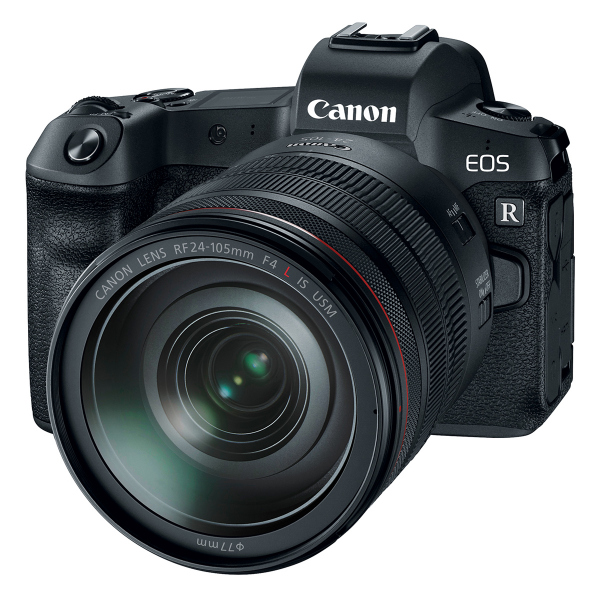
Promotional pictures ©2018 by Canon | |||
Don't expect me to discuss the specs of both cameras; you can find them everywhere (DP Review being a good place to start, with a dozen or so Day 1 articles already there). Let me just raise four points.
So what may stop the Nikon Z-Series from becoming an outright success? Just one thing: it is six years late. About this picture. From time to time I declare a Day of Mercy: going through my image files selected for deletion (sometimes years ago!) and pardoning a few, just to see what can be done with them. This time I stumbled upon some Kodachromes, digitized in 2004. Just a few frames I completely forgot about; the real stash still awaits the scanner.
| Here is the first image I kept, in both color and monochrome (with the former more to my liking). The Swapper stack also includes the original scan, unaltered (except for size reduction), so that you can see why it was to be discarded. The postprocessing in PSP 20 was quite intrusive and included Fill Light, Local Tone Mapping, Curves adjustment, deblur with Focus Magic and denoising with Neat Image. I hope the result was worth the hassle.
| 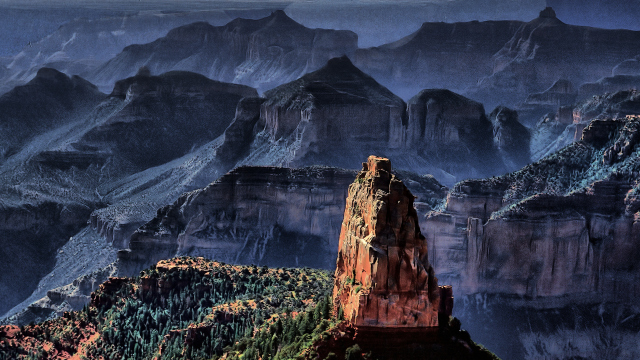
Minolta XD-5, MD Rokkor 50/1.7, 2× teleconverter
| |
Remember the GPD Pocket mini-notebook computer from last year, fitting into (almost) any camera bag? I've been using one for a year now, and I'm happy with it, within the limitations imposed by size, price, and power use. A photographer's friend, indeed. Now, looks like the updated version, the GPD Pocket 2, will be coming our way this October. This one is even harder to resist: almost double the CPU performance, still sipping the power at 5 W, improved keyboard layout. Still just 128 GB of a (slow!) solid-state drive, but at least a MicroSD slot. No doubt: I need one. I do.
| For the last month Nikon has been running a teaser ad campaign, preparing the ground for a press release of a "full frame" mirrorless camera system. The news is expected within a few days. Excuse me, is this the same Nikon who, ten years ago, said they were not really interested in EVF system cameras, or who considered Sony no threat to their SLR business? Or am I confusing names? For the last month or two Canon has been dropping hints about a similar system of their own (after testing the waters with the M-Series, using the APS-C frame). Excuse me, is this the same Canon [...] (see above) Picture: Grayson County, Virginia
| 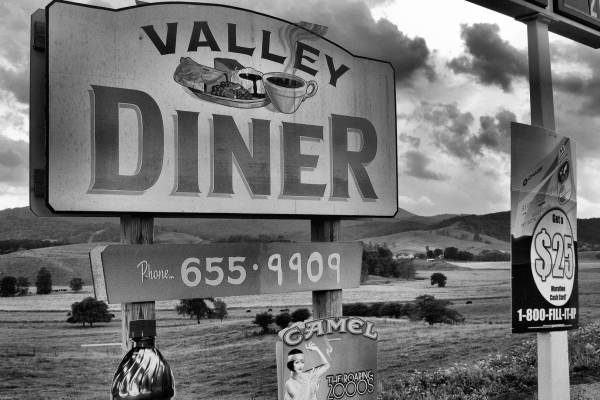
Olympus E-300, ZD 14-45/3.5-5.6 @ 21 mm
| Ten years ago Olympus and Panasonic announced the Micro Four Thirds standard. Strangely, only Panasonic followed that promptly with an actual camera: the G1, a proof they meant business. All Olympus was able to show was a wooden mock-up of a finder-less model, a rather pathetic effort. Only in June of the next year (2009) did Olympus manage to make an actual μFT camera: the cute but monitor-only E-P1, followed within months with the "done right" version, the EP-2, accepting an add-on EVF. This was the beginning of the finder-less Pen family, still alive today (I hope). While Panasonic kept releasing finder-equipped μFT models, it was only in 2012 when Olympus came up with (what many consider) their first μFT-based system camera: the OM-D E-M5, followed the next year by the technological tour de force, the E-M1 and other models of the OM-D family. For many, myself included, this is when Olympus really came back to the game table; see The Road to E-M1 Enter Sony, who in 2006 bought what was left of Minolta (or Konica-Minolta), trying to enter the SLR market. In 2010 they saw the writing on the wall and went mirrorless, both APS-C and full-frame. This move was just ignored by Canon and Nikon, apparently assured of their market dominance. After eight years they still have the whole full-frame mirrorless market for themselves (except for some exotic offers by Leica, with Leica pricing). In the APS-C segment, Sony is now competing against Fujifilm and, yes, Canon (the M-series, introduced on 2012), but also against μFT. Last but not least, medium-format makers went mirrorless, too (Fujifilm, Pentax, Hasselblad): with the 44×33 mm frame size, getting rid of a moving mirror offers a considerable advantage. Now a piece of news. According to just-published U.S. trade data for the first half of 2018, Sony was the top brand in full-frame camera sales (SLR or not), both in terms of dollars spent and units shipped. About 40% of full-frame cameras sold in the States were Sony (mirrorless), with the remaining 60% being all (or almost all) SLRs by Nikon and Canon. This is just the U.S. Sony does not lead the full-frame market elsewhere. It became clear, however, that for the Canon/Nikon duopoly the only chance of defending their market share in system cameras will be in going mirrorless. This is the type of camera which will dominate the market in a year, maybe two, regardless who will be making it: Canon, Nikon, Sony, or Burger King. This had to happen. In fact, it took longer than I expected. To quote myself from a 2005 article for the Quest, a British Olympus Circle newsletter:
[The] EVF-based cameras may soon provide, arguably, the best of both worlds: real-time viewing of a quality comparable with today's SLRs, with less mechanical complexity and at a lower cost. [...] EVF cameras may [...] soon dominate the middle segment of the market (advanced amateur), with SLRs withdrawing to the higher ground [...] This is exactly what is happening now. I must have been living under a rock for some time, as only last month, when getting familiar with the Panasonic GX9, I've learned about that camera addressing lens diffraction in the firmware. Actually, two previous Panasonic models already had this feature. Surprisingly, that fact went largely unnoticed in the μFT community. It is quite important, though, and for more than one reason. Watch this space. Panasonic is using a game-changing technique called deconvolution to do the job. At this moment I'm aware of just one other manufacturer using deconvolution to fix lens diffraction in a camera: Pentax, in a 2014 firmware upgrade for their K-3. It is also used in some postprocessing software by Adobe and Canon. as well as RawTherapee and GIMP. Researching the subject, I came across a software for deblurring photographic images, called Focus Magic, which uses it as well.
| I've tried it, liked it, and bought it. Then I spent a week learning more about it, experimenting, producing sample images, comparing and scrutinizing. This Focus Magic report shows my findings and results. It uses multiple instances of Swapper for critical sample comparisons, detecting differences which otherwise would be easy to miss. Here is one of the image samples from the report. The thumbnail links not to the whole frame, but to a full-scale crop, 1080 pixels tall. The picture (in-camera JPEG), in addition to cropping, was submitted only to a slight deblurring with Focus Magic, no other processing. (The full original frame, not deblurred, is here.) See the article for more.
| 
Olympus E-M1, MZD 75/1.8 | ||||
|
|
Two new Gallery pages are being posted today.
San Juan, Puerto Rico, which we always wanted to see, but always something urgent would come up. Finally, a few years ago we managed to stop there on our way home from Dominica, for just two nights. Two weeks would have been much more appropriate. I'm having a problem deciding which of the three crops I've tried for this frame works best. I like them all. This Swapper lets you compare. More Urban Sunsets, exactly what the title says, all shot over the last two months.
| 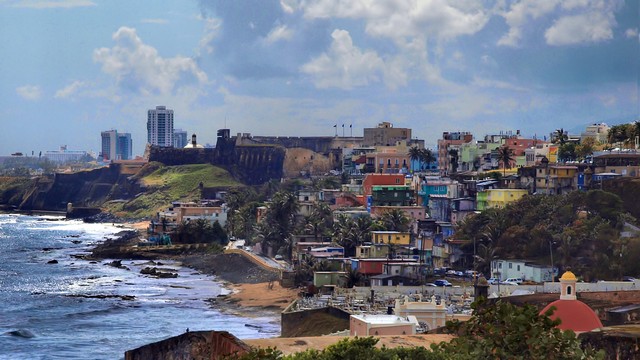
Olympus E-30, ZD 12-100/2.8-4.0 at 54 mm
At, the same time, the original Urban Sunsets and Yellowstone have been retrofitted with a Flipper (more retrofits to come).
| |||
|
Look, Ma, no Tripod! — just in time for the Fourth of July, a how-to article about shooting fireworks from hand with some help of your camera's Image stabilization.
| The procedure involves combining a few frames into a composite picture, so a purist can refer to it as "cheating". Look at it from another angle: what's the difference between a frame using a single exposure of eight seconds, or the same eight seconds split into four separate frames and then combined? The examples come from one session, the last New Year's midnight. One is shown at the right. (Remember: this is a Swapper; hit the [H] key while in full screen to see your options!) Happy Fourth of July to my U.S. Readers, may your steaks turn out juicy! (I could use one now, with a huge crab cake on the side, if possible.)
| 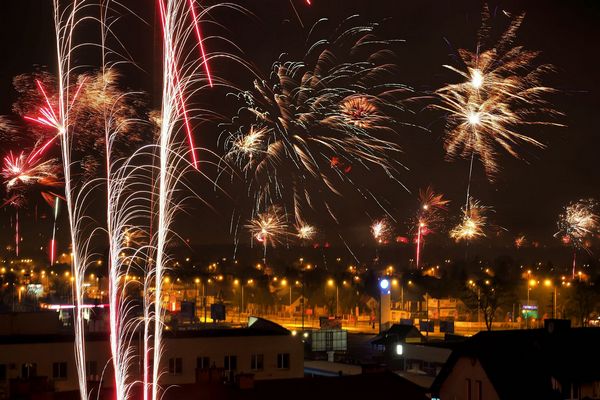
Olympus E-M1 Mk. II, MZD 12-40/2.8 at 40 mm
My Panasonic GX9 write-up is, at long last, done (sort of, at least). It is much bigger than planned; that's why it took four months, given all distractions on the way. A very attractive camera, indeed; for most users it will be, I think, a better choice than the E-M10 Mk. III (if not quite up to the level of Pen F, but consider the price).
| |||
My Swapper got a major upgrade: when showing panoramic images (or any with aspect ratio wider than that ofFur screen), it offers a choice of two display modes:
Click on the image below to see how it works.
|
|
Well, this looks like something I always needed: a civilized way to present panoramic images in Web pages. Importantly, it will be quite easy to retrofit my existing code with the new mechanism: all it takes is to modify each image link, a fairly mechanical task.
|
I'm still in Poland, and it may be a good while until I come back to the States. Medical reasons, a long story, but I'm in good hands, in both meanings of the p hrase.
The bad news that at least two lenses I like so much (the Leica DG 8-18/2.8-4.0 and MZD 12-40/2.8) are on the other side of the Atlantic, and so are any spare bodies I could use. Besides that, business as usual; I can even work remotely for my employer based in Maryland. Well, you never know.
| 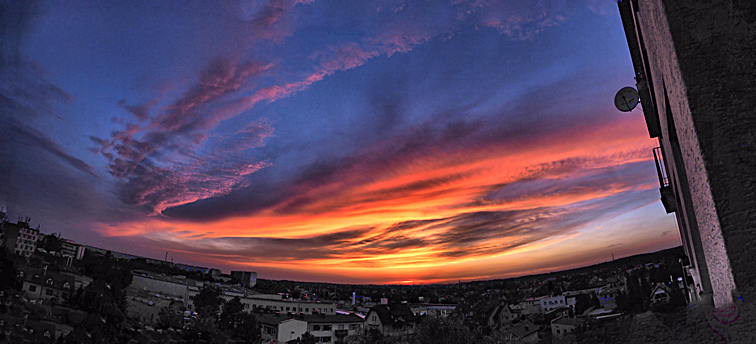
Olympus E-M1 II, MZD 12-100/4.0 @ 12 mm
|
While in Łódź (pronounced as Woodsh), we are treated, weather permitting, to a daily show of sunset and what follows immediately after.
Sometimes they are quite spectacular, like the one from last week. Here, with the Sun just below the horizon, both components of the Magic Hour stand out perfectly: gold-copper and intense blue. The four in-camera JPEGs used were a bit dark, with no visible shadow detail; postprocessing in PSP 20 (after stitching in MS ICE) took care of that. I'm quite happy with the results, best appreciated in full-screen viewing. The curving horizon is an artifact of the panorama stitcher and can be easily straightened up. I did that (see the Swapper), but I like the curved version more. | |||||
|
The Great Silk Road: after having posted the new Gallery page on Samarkand, I went back to my other Silk Road pieces and re-did the postprocessing of all image scans. Khiva is now no longer in black-and-white, while Bukhara got some extra color punch.
|
Look what we've got here. The time is 1981, the place — legendary city of Samarkand in Soviet Uzbekistan; a capital of empires, home to poets, doctors, and astronomers, now a sleepy, forgotten town somewhere in Central Asia. And this is the local marketplace.
I just finished a "better" postprocessing run through my ORWO UT21 slide scans from Samarkand (1970, 1975, 1981), and here it is my newly-posted Samarkand Gallery page. Technically, these images do not impress. The East German ORWO slide film I used, the only option East of the Iron Curtain, was rather bad to start with, and did not age gracefully. The grain was obscene, and some colors way off-mark. Still, the pictures are mostly better than those you can find on Wikipedia, and it would be a shame not to post them.
See my other two Silk Road Galleries:
| 
Minolta XD5, lens and exposure not recorded
|
|
The Magic Hours article: it took me another five days to finish it. Sort of. The title has changed in the process, so did the scope It is no longer just about postprocessing, as originally intended.
Obviously, updates will follow. For now, the piece briefly explains how the light separates into blue and red components, how they affect the image, and how their proportions change with time. Yes: the Golden Hour and Blue Hour are two parts of one and the same, superimposed, with continuously changing proportions. Six examples are included, each showing the steps of processing from the in-camera JPEG to the final (?) image; some with extra options. These are not intended as recipes, but rather as a starting point suggestions to your own experiments, if you decide to go deeper into the subject. The article uses a lot the Flipper mechanism for displaying multiple images. I'm quite happy with the way Flipper and Swapper work, and both got a few updates last week.
| 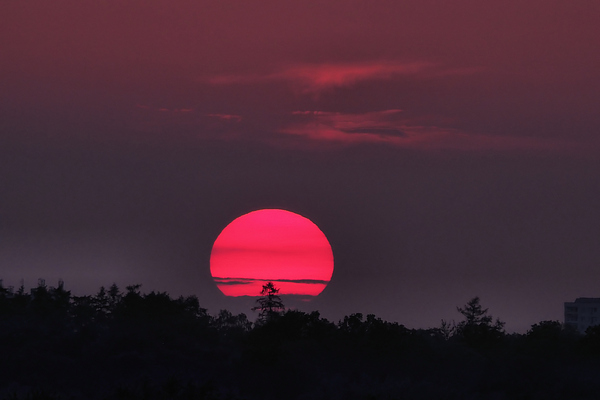
Olympus E-M1 Mk.II, MZD 75-300/4.8-6.3 at 300 mm, cropped
|
|
You have been warned: last night I re-shot my blue-hour balcony scene, this time without HDR and at ISO 400. The exact time was 9:38 PM.
With no HDR, the underexposure was as intended, a perfect material for JPEG postprocessing. I applied just a little of Fill Light and Local Tone Mapping, then a tad of Lightness in green, and finally moved mid-tones down a little in Curves. This was followed by some sharpening and denoising, although these were not really necessary. No masking. While the "golden hour" shooting (just before the sunset or, for early birds, just after the sunrise) is quite common, the "blue hour" (just after sunset or before sunrise) remains a less-explored territory. Too bad, as it is capable of delivering some most pleasing, and often unexpected, results. The Blue Magic is my newly-posted article on the subject; just a starter (appetizer?) at the moment, with more to come.
| 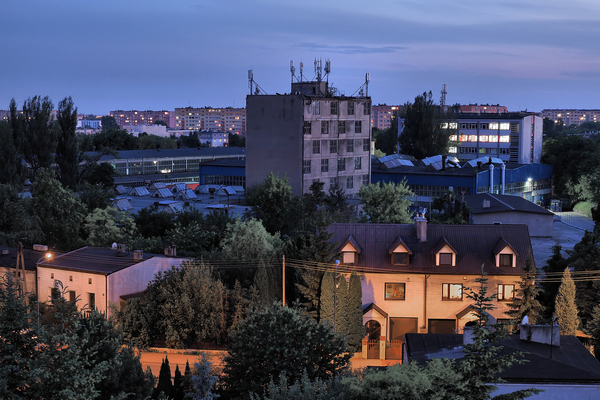
Olympus E-M1 Mk. II, MZD 12-100/4.0 at 29 mm AP (-0.3EV): 8 s at F/8, matrix, AF, light tripod and OI Share Natural Picture Mode (S-1,C-1) Moderate postprocessing in Paint Shop Pro 20
|
|
This picture was taken last night at 9:34 PM, more than 45 minutes after the sunset. The abandoned factory amidst concrete block apartment buildings; something Philip K. Dick-ish.
All frames, shot in the HDR Mode 1 with exposure compensation set from -1 to +0.3 EV, turned out underexposed and, strangely, the compensation value did not seem to matter. I suspect that's what happens on the E-M1, without any warning, when you run out of usable exposure range in HDR. I was prepared to throw them all away and re-shoot the session tonight (no HDR this time), but then changed my mind. Slight perspective correction in PSP 20, followed by Fill Light, Local Tone Mapping and boosting the lightness of greens, did the job. Admittedly, the postprocessed image looks nothing like I remember the scene. I like it better this way. Still, I will be coming back to this motif, unless I get a restraint order. Consider yourself warned.
| 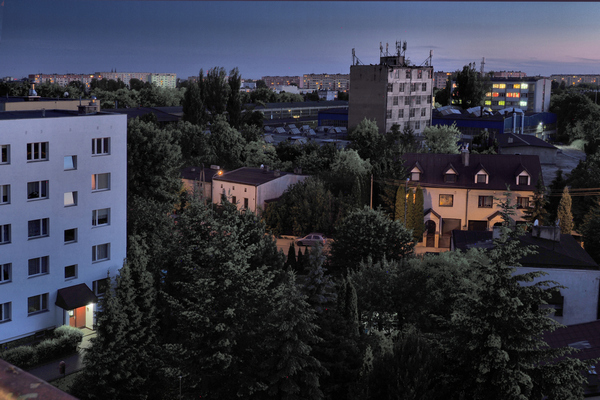
Olympus E-M1 Mk. II, MZD 12-100/4.0 at 20 mm HDR-1 Mode, AP (-1EV): 4 s at F/8, bracketing ± 1EV, matrix MF (peaking), light tripod Heavy postprocessing in Paint Shop Pro 20
|
Swapper and Flipper, two Web-authoring tools I wrote to use on this site, got a detailed technical write-up in the new Photo Bytes section, devoted to using computers in photography.
| Those who dabble into Web development may want to try Swapper and Flipper out: the downloads are tiny and don't require any other software beyond a Web browser and text editor. This Picture: another snapshot of the famous Piotrkowska Street in Łódź, Poland. This time an artist's studio, overlooking a crowded pedestrian area. And yes, I'm showing three very different versions of this picture in a Swapper. (The others are more heavily postprocessed, and my preference varies with the time of the day and the phase of the Moon.)
| .r.jpg)
Olympus E-M1 II, MZD 12-100/4.0 at 61 mm | |||||
|
You think this is a nice one? Wait until you see it in monochrome. A tough choice, indeed!
Experimental: The
Swapper, a new HTML tool I wrote for this site to switch between images with arrow keys. Better than clicking on two links.
This is a 16:9 crop of one of the frames from my new South Dakota Badlands gallery page, shot three years ago and just posted. I liked some of the B&W versions much enough to include a separate monochrome Badlands page. Both pages have been instrumented with the Flipper, so that you can move between full-screen images without returning to the thumbnails. |
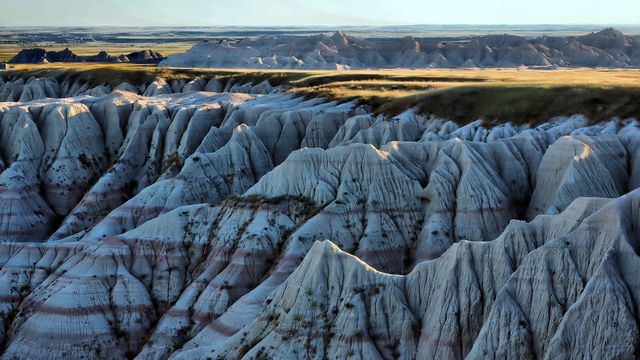
Olympus E-M1 Mk. II, MZD 12-100/4 @ 14 mm |
|
Additionally, I am using some Badlands frames in a small case study article on landscape postprocessing. While my experimenting was done in Paint Shop Pro, the article is applicable to most of photo-editing applications.
| |
|
Yes, I've been in Poland for six weeks now, sitting mum, busy with all the stuff unrelated to photography; let me spare you the details. Now I'm considering a retirement here, after 35 years of living and working in the United States. We'll see.
This picture: a mural in a rather neglected part of my original hometown of Łódź, Poland, painted by the ETAM Cru, a highly-recognized team of street artists.
The picture was shot in very tight quarters, with quite a lot of perspective distortion — see the original frame (reduced). This required quite a lot of perspective correction, which Paint Shop The thumbnail at right may seem a bit dark and muddy, because of the bright page background. Click on it to see a larger version (otherwise unchanged), on a dark background (except for Microsoft browsers). The tonality is then just right, for my taste at least. The Microsoft browsers should be just avoided. If you are still using either of them, switch to something else. Anything else. My own choice is Opera (ad suppression and VPN built-in), but Chrome, Firefox, and Vivaldi are also very good (and all except Firefox share the same rendering engine). See also my article on Web browsers.
|

Olympus E-M1 Mk. II, MZD 12-100/4 @ 14 mm |
|
Got a new laptop to replace my dead Alienware. This time my choice was the ultralight Lenovo 720S with the 15-watt AMD Ryzen 5 2500U processor (a Ryzen 7 model would be better but it wasn't yet available at the time).
With a 13.3", narrow-bezel, non-glare screen (glossy ones disqualify a computer in my book), 500 GB of solid-state drive, and first-class build quality, this is a strong contender against the top configuration of the Dell XPS 13 (which used to be my first choice in this size/weight class). What tipped the scales, however, was the AMD CPU. At long last, AMD has mobile processors competing with the Intel i5/i7 series (and with better integrated graphics), free (or almost free) of the recently discovered Intel security problem. Additionally, this 720S was priced at just $900 — less than any laptop I bought in the last 25 years. Unfortunately, Lenovo tried to cut some corners, not using a faster RAM in the 720S. This hurts the performance more than I expected. Boo. While this is still a very nice laptop, it is not a champ it could have been (see, for example, my own benchmarks). This is now my principal computer, used for image archiving and processing, for software development and work-related air traffic applications, and for maintaining this Web site. Regardless of that, I'm using the GPD Pocket mini a lot (perhaps 50% of the time); not just for travel, but also moving around the house, or going to bed, not to mention tethered photo sessions. | |
|
|
Above: shot from my doorstep two weeks ago. After all, spring may yet come this year to Maryland.
In the meantime, I'm off for Poland today. Again. This time taking the 12-100 and 75-300 along. Every time I travel, the Lumix GX9 seems more and more attractive (the article still not quite done, but progressing). Well, I'm still waiting to see the specs of the (hopefully) upcoming
Panasonic seems to be serious not just about the μFT cameras, but also about lenses in that standard. Two premium ones, co-branded with Leica (whatever exactly that means) should be available soon: the 200/2.8 and the 50-200/2.8-4. The latter completes the premium "2.8-4" trio (which also includes the 12-60 and
A Panny for the rest of us? The recent announcement of the Lumix GX9 by Panasonic got a mixed reception from the μFT aficionados discussing it on Internet forums. Let me add my own twopence.
| I suspect the commotion is due, mostly at least, to the convoluted, and somewhat inconsistent, naming scheme used by Panasonic for their Micro Four Thirds cameras. Many users expected the GX9 to be the next step in the GX line evolution, quite like that from GX7 to GX8; this would be logical, but the line seems to have taken a turn in a somewhat different direction. To me, this looks rather like a new attempt to define specs and features of an "enthusiast market" camera. This calls for some compromises. As a result, Panasonic came up with a camera appealing to a significant number of users (or potential buyers) in this market segment, myself included — and at a most attractive price.
| 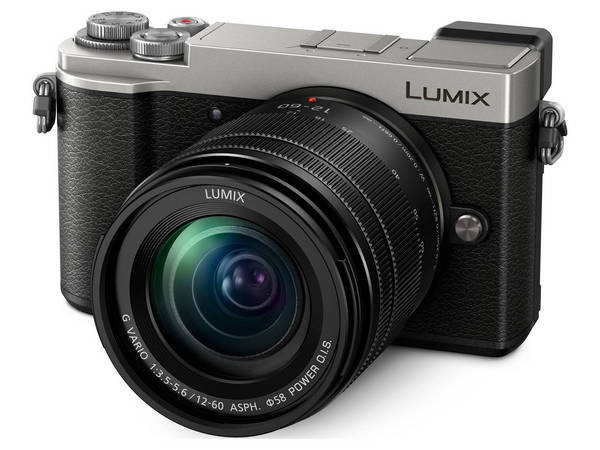
(Promotional image © by Panasonic)
|
Priced at $1000 (in the U.S.), including a respectable 12-60 mm zoom, the GX9 is in a good position to compete with the PEN F by Olympus. I hope Panasonic will sell lots of them. In the meantime, I'm presenting the cameras basic specs, and some discussion, in a separate GX9 article (under construction).
A sad news. A feeling of loss. My dear friend, Jerzy "Jurek" Knapik passed away last Sunday in a Warsaw heart clinic.
| We've been close buddies and classmates at the University of Łódź, Poland, for five years; then we got jobs in the same research group. Partying together, hiking together and doing physics together — until our ways separated: I ended up doing air traffic R&D in the U.S., while Jurek represented Poland at the U.N. Atomic Energy Agency in Vienna, Austria. After retiring, Jurek looked me up on the Internet, and for the last year we've been talking on the phone at least twice a week, like if that 30-year break never happened. Photography, computers, and technology in general were among many interests we shared. Last November he said he regrets we wont see the inventions and gadgets coming after us. In the meantime, he was enjoying his brand-new Sony superzoom. He also became an expert in (of all things) miniature Nativity scenes from around the world, and his massive collection has been hosted by a number of museums in Poland. We've been planning to meet in person late January, but this is never going to be.
| 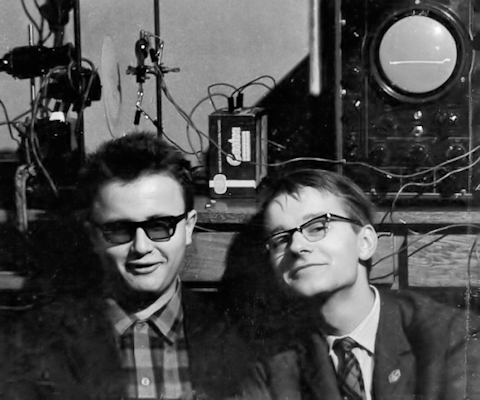
Jurek and me
| ||
|
I'm back home in Maryland. We made our connection in Copenhagen just in time, and the Airbus 340, used by SAS on transatlantic flights, has individual USB power outlets.
(At 5V/1A they are not enough to recharge a depleted GPD Pocket, but will keep it, if barely, going. This will not work with a "regular" ultralight.)
| Here is the Warsaw airport main terminal, as seen from our window at the hotel where we spent the last night before the departure. All bugs, glitches, and idiosyncracies aside, Pain Shop Pro shows its flexibility and power when used for images like this one. Fill Light and a tad of Local Tone Mapping did a most pleasing job of tonal adjustment (especially, but not only, of extracting the shadow detail). The monochrome version, my choice, was done with the B&W Film tool, with blue filter applied. Yummy.
Update: Compare both in
Swapper.
| 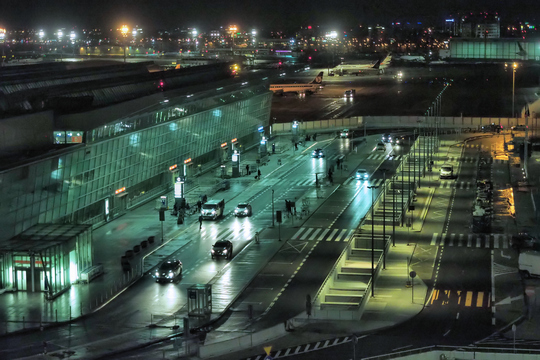
Olympus E-M1 II, MZD 12-40/2.8 at 40 mm
|
The last step of postprocessing, noise removal, was done with the Neat Image plugin (most Photoshop plugins work with PSP just fine). This is my favorite noise-removal tool, and I'm happy to report that the current Version 8 seems to be a major upgrade, unlike the previous steps to Versions 6 and 7. Most of all, there is an option to use a more effective algorithm (thee times more CPU intensive), small but nice changes in user interface, and more control (only if you need it) over the process parameters.
My experience with the new (slow but efficient) method of noise removal is limited to two dozen or so of high-ISO frames so far; not enough for any conclusions, but the results look very, very pretty. (If I could find some time to do a comparative sample series...) Overall, this is the most comprehensive Neat Image update I can remember, and I think it is worth the $35 asking price (a new licence costs $70). If you don't have a plugin-compatible host application, there is also a stand-alone executable at the same cost. | ||
|
Happy New Year, everyone. I'm meeting 2018 in Poland; back in the States in four weeks.
My laptop's fan finally died; I had it replaced in a repair shop with one I brought from the States. The system, however, does not seem to use the fan; worse, it stopped charging the battery. I replaced the battery with one shipped from Hong-Kong, still no luck. Back to the shop tomorrow. I'm glad I have a full, up-to-date backup, almost a terabyte of it. Thus, for the last two weeks my only computer has been the tiny GPD Pocket, and I must admit the little sucker is proving itself quite admirably. I'm using it mostly for Web development and some lightweight image postprocessing; no CPU-heavy tasks. |
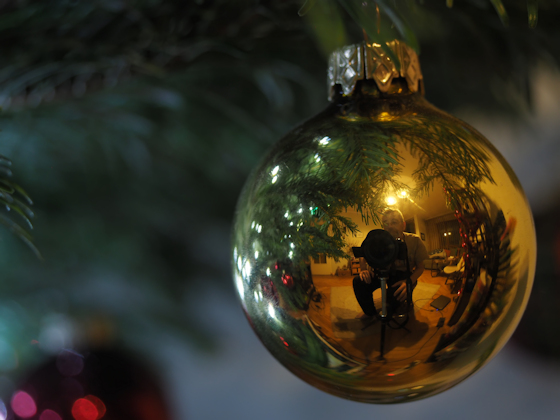
Olympus E-M1 II, MZD 12-40/2.8 Pro @40 mm |
|
My Exakta section underwent a serious facelift last week. Mostly formatting cleanup, but not only. It was neglected in the last few years. Not that it matters: in this area events move at their own, slow pace, year-to-year rather than week-to-week or faster. First of all, I wasn't aware of a new book: Exakta — a Brief History of Excellence (see here). There is but one problem with it: it is in Polish, and the plans for the English translation, while announced, seem rather foggy. On the flip side, Polish happens to be my native language, so when I discover something of interest, I'll share it with you. Interestingly, the authors chose to use in the book my star notation for Exakta and Exa version taxonomy. I am glad to report that Camerapedia, the most comprehensive Web reference on camera models, also started using the same classification for 35-mm Exaktas and Exas. | |
 |
 |
 |
 |
 |
 |
 |
| Home: wrotniak.net | Search this site | Change font size |
|
Posted 2006/01/30; last updated 2018/12/29
|
Copyright © 2006-2018 by J. Andrzej Wrotniak
|